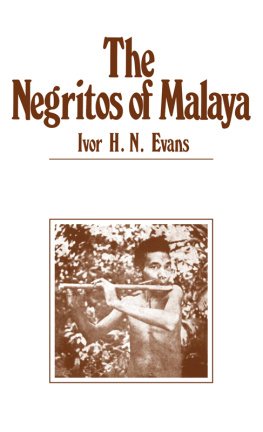Letter of Transmittal
Department of the Interior,
The Ethnological Survey,
Manila, March 3, 1904.
Sir: I have the honor to transmit a study of the Negritos of Zambales Province made by Mr. William Allan Reed, of The Ethnological Survey, during the year 1903. It is transmitted with the recommendation that it be published as Part I of Volume II of a series of scientific studies to be published by this Survey.
Respectfully,
Chief of the Ethnological Survey.
Hon. Dean C. Worcester,
Secretary of the Interior, Manila, P. I.
Letter of Submittal
Department of the Interior,
The Ethnological Survey,
Manila, March 1, 1904.
SIR: I have the honor to submit herewith my report on the Negritos of Zambales.
Very respectfully,
William Allan Reed.
Dr. Albert Ernest Jenks,
Chief of The Ethnological Survey, Manila, P. I.
Table of Contents
- Letter of Transmittal
- Letter of Submittal
- Illustrations
- Preface
- Chapter 1: Distribution of Negritos
- Present Distribution in the Philippines
- In Luzon
- In the Southern Islands
- Conclusion
- Chapter 2: The Province of Zambales
- Geographical Features
- Historical Sketch
- Habitat of the Negritos
- Chapter 3: Negritos of Zambales
- Physical Features
- Permanent Adornment
- Clothing and Dress
- Chapter 4: Industrial Life
- Home Life
- Agriculture
- Manufacture and Trade
- Hunting and Fishing
- Chapter 5: Amusements
- Games
- Music
- Dancing
- The Potato Dance, or Pia Camote
- The Bee Dance, or Pia Pa-ni-lan
- The Torture Dance
- The Lovers Dance
- The Duel Dance
- Chapter 6: General Social Life
- The Child
- Marriage
- Rice Ceremony
- Head Ceremony
- Leput, or Home Coming
- Polygamy and Divorce
- Burial
- Morals
- Slavery
- Intellectual Life
- Chapter 7: Spanish Attempts to Organize Negritos
- Anthropometric Measurements
- Vocabularies
- Plates
Illustrations
- I. Outline map of the Philippine Islands, showing distribution of Negritos. 18
- II. Outline map of Zambales, showing distribution of Negritos. 30
- III. Negrito women of Bataan on a rock in a stream. 30
- IV. Negrito man from Nangsol, near Subig, Zambales. 30
- V. Negrito man from Aglao, Zambales. 30
- VI. Negrito woman of Zambales. 30
- VII. View near Santa F, Zambales. 30
- VIII. Capitn of Villar. 30
- IX. Negrito man of Zambales. 30
- X. Showing the relative height of American, mixed blood and pure Negrito. 30
- XI. Group of Negritos and Constabulary at Cabayan, Zambales. 30
- XII. Old man of Zambales, pure Negrito. 30
- XIII. Old man of Zambales, pure Negrito, showing hair on face and chest. 30
- XIV. Negrito of Zambales, showing hair on the chin and skin disease on the arm. 30
- XV. Pure Negrito of Zambales, showing hair on the chin. 30
- XVI. Negrito Man of Zambales, showing hair on the face. 30
- XVII. Negrito girls of Zambales, one with hair clipped behind to eradicate vermin. 30
- XVIII. Negrito man of Zambales, pure blood. 30
- XIX. Negrito man of Zambales, mixed blood. 44
- XX. Negrito man of Zambales, pure blood. 44
- XXI. Negrito man of Zambales, mixed blood. 44
- XXII. Negrito girl of Zambales, pure blood . 44
- XXIII. Negrito woman of Zambales, mixed blood. 44
- XXIV. Old Negrito woman of Zambales, pure blood. 44
- XXV. Negrito man of Zambales, pure blood. 44
- XXVI. Negrito man of Negros, mixed blood. 44
- XXVII. Negrito man of Zambales. 44
- XXVIII. Negritos (emigrants from Panay) of Maao, Occidental Negros; mixed bloods. 44
- XXIX. Group of Negrito men at Santa F, Zambales. 44
- XXX. Principal men of Tagiltil, Zambales; pure Zambal and mixed Negrito. 44
- XXXI. Negritos of Zambales, mixed bloods. 44
- XXXII. Group of people called Aburlin; non-Christian Zambal and Negrito mixed bloods. 44
- XXXIII. Negrito women of Zambales. 44
- XXXIV. Group of Negrito women at Santa F, Zambales, showing dress. 44
- XXXV. Negrito girls of Zambales, one wearing necklace of dried berries. 58
- XXXVI. Combs worn by Negritos of Zambales. 58
- XXXVII. Ornaments worn by Negritos of Zambales. 58
- XXXVIII. Negrito man, wife, and hut, Bataan. 58
- XXXIX. Better class of Negrito hut, Zambales. 58
- XL. Negrito man of Bataan making fire with bamboo. 58
- XLI. Negrito men of Bataan making fire with bamboo. 58
- XLII. Bows and arrows used by Negritos of Zambales. 58
- XLIII. Position taken by Negritos of Zambales in shooting. 58
- XLIV. Negrito man of Bataan drawing a bow; hog-bristle ornaments on the legs. 58
- XLV. Negrito man of Negros (emigrant from Panay) drawing a bow. 58
- XLVI. Musical instruments used by Negritos of Zambales. 58
- XLVII. Negritos of Zambales singing the talbun. 58
- XLVIII. Negritos of Zambales dancing. 58
- XLIX. Negrito men of Bataan beating gongs and dancing. 58
- L. Negritos of Zambales dancing the torture dance. 58
- LI. Negrito woman and daughter, Bataan. 72
- LII. Pure Negrito woman and mixed blood, with babies, Zambales. 72
- LIII. Negrito women and children, Zambales. 72
- LIV. Negrito children, Santa F, Zambales. 72
- LV. Capitn of Cabayan, Zambales, with Negrito and Zambal wives. 72
- LVI. Boys of Zambales, showing scars made by blistering for fevers, etc. 72
- LVII. Negrito woman of Zambales, pure blood, showing scars made by blistering for fevers, etc. 72
- LVIII. Negrito woman of Zambales, pure blood, showing skin disease. 72
- LIX. Negrito man of Zambales, mixed blood, showing skin disease. 72
- LX. Negrito boy of Zambales, mixed blood, showing skin disease. 72
- LXI. Negrito man of Zambales, mixed blood, showing skin disease. 72
- LXII. Capitn-General del Monte, Negrito of Zambales. 72
- Figure 1. Belatic, trap used by Negritos. 45
- Figure 2. Marks on dice used by Negritos. 49
Preface
This report is based on two months field work pursued during May and June, 1903. Accompanied by Mr. J. Diamond, a photographer, the writer went in the latter part of April to Iba, Zambales, where a few days were spent in investigating the dialects of the Zambal people and in preparation for a trip to the interior.
After a journey of 25 miles inland a camp was established near Tagiltil. During the three weeks we were there the camp was visited by about 700 Negritos, who came in from outlying settlements, often far back in the mountains; but, owing to the fact that most of them would remain only as long as they were fed, extended investigations had to be conducted largely among the residents of Tagiltil and the neighboring rancheria of Villar.










